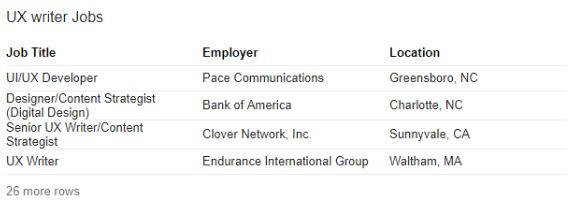For a while now, the abbreviation ‘UX’ – short for user experience – has been circling around on the internet. So far, however, the main way it’s been used is for design. Where to put button and if you should use the hamburger button or not. What hasn’t really been discussed is how to write correctly to enhance people’s user experience.
Recently, that’s been changing. And it’s about time! Because really, if you’re going to worry about the user experience in terms of which line you should put where, you should also worry about the text you’re going to put in between those lines!
So why haven’t people worried about it so far? Probably that’s down to non-writers thinking that all writing is the same.
Of course, that – as anybody who has ever read an advertising blurb – isn’t the case at all. Sometimes text is meant to be emotional. Sometimes text is supposed to be explanatory. And sometimes, as all of us who’ve had to read research papers know, they’re meant to obscure.
Today, you’ll all be happy to know, we’re not going to be talking about academic writing. Instead, we’re going to cover how you can write good UX copy.
1. UX Writing – An Introduction
Source: pexels.com
In short, UX writing is about designing the text that people use
to interact with software. To put it another way, it’s about the interaction between the user and the
software they’re using. Of course, some software can do that interaction without actually using language.
But really, that’s only the simplest of programs. As soon it gets a little bit more complicated you’re
going to need language.
The good news? If you’re good at other types of writing, you’ll quickly be able to learn the ropes in terms of UX writing as well. So, don’t let the ‘u’ or the ‘x’ intimidate you! Many of the things that make other types of (non-fiction) writing good will also help you with writing good UX copy.
Of course, there are some differences. The biggest one being that you’re really restricted in terms of how much language you can use. In that way, you can say that it’s a bit like poetry. You’re trying to squeeze as much meaning into the words that you’re using as possible.
Another one is that this type of writing is very data driven. You’ll often design an instruction, test it by letting people use it for a while, and then make changes based on if they get stuck, frustrated, or abandon the software. This is actually hugely advantageous as it means you can quickly learn where your turn of phrase doesn’t actually work as you think it does, which can make you a better writer more quickly than in other fields.
2. UX Writing – How To Do It Well

If you want to excel at UX writing then there are a number of things that you have to focus on doing and doing well.
Write For The User, Not For The Developers.
This is possibly the most common problem that beginning UX writers have. They work with developers and end up using developer speak in their writing. The developers might even encourage it, thinking that if they understand it, everybody else will as well. But often that’s not the case.
Instead, you need to write with the user in mind. Mainly, that means that you don’t focus on the software problem, but the action that they’re trying to for. So, if they make a mistake writing their password, you don’t focus on the problem (a failure to authenticate) but on what they did wrong (there was as sign in error).
Use Short Words And Sentences
It isn’t just academics who will be using your software. Instead, every man needs to be able to understand your language. The two best ways to get there is to use both short words and short sentences. The moment your words pass two syllables in length and your sentences stretch out beyond ten words, alarm bells should start ringing. Find easier ways to say things, preferably in a way that people do not feel intimidated.
For example, we could take the ‘there was a sign in error’ from above and simplify to ‘the password you entered was incorrect’.
Get To The Point
People who are using programs don’t read. They skim. This means they’ll generally read the first few lines and then start jumping down to find what they’re looking for.
Yes, it is entirely unfair and yes, you can get annoyed and angry about that, but it won’t do you much good. A much better strategy is how to accommodate that into your writing. First and foremost, that means that the most important stuff has to go first.

In news writing they call this technique ‘front loading’. You start with the most important information and then supply whatever else they might be interested in further down. In fact, this is a hugely effective writing strategy for almost any kind of non-fiction writing, be it reporting or essay writing, so make sure you take the lesson to heart as much as possible.
I found that the best way to become a better front loader is to write like you normally do and then get in the habit of deleting the first few lines (or even paragraphs). That’s because often they’re all preamble, that don’t add much.
Offer A Solution
Of course, highlighting the problem is not enough. You’ll also want to make sure that you offer actionable steps that they can take to solve the problem. In that way, they know what they’re supposed to do and don’t end up getting frustrated.
With the above example of the password, you’d probably want to give them two possibilities. The first is another attempt and the other is to recover their password, somehow. Most of the time these two options are presented as ‘try again’ and ‘I forgot my password’.
Know The Conventions
Finally, you have to understand what people expect. Expectations is a powerful tool. For example, if we’re looking to access the menu, we’ll often look down the left-hand side, or the top bar of a page. Recently, a new way was added (which I already mentioned before) which is commonly referred to as the hamburger button. Initially, UX designers were up in arms about it. Now, however, it has once again become convention and people everywhere are using it.
There is a lesson in that. You can defy convention, but if you do so, make sure that whatever idea you come up with will actually be better than whatever the convention is. Even then, you can be pretty sure that people will probably object. Only time will tell whether you were right or they were.
Try And Try Again

As I already mentioned above, the great thing about UX writing is that you can often get direct feedback
about how you can do it better – particularly if the software you’re a part of is online. You can find out
at which step people are struggling to interact with the software correctly and then go in to actually fix
that.
This is hugely important and is something you’ve got to become good at.
You’ve got to learn how to analyze the data that’s coming through (or work with people who can do that for you) and then actually take action when you find a problem.
Often, that means you’ll have to drown your own babies. Yes, that does sound hard. The thing is, sometimes you think you’ve come up with a genius solution for a problem, only to find out it goes straight over people’s heads. Of course, you can try to tweak it, but if you want to be successful as a UX writer sometimes you just have to bite the bullet and throw it out.
3. UX Writing – What Kind Of Writer Do You Need To Be?

So, then the question becomes, what kind of writer is going to be the best suited to this kind of writing? Let’s look at some of the most important attributes that you’ll need in order to do well in this regard. You have to:
Understand Development
Step number one is that you need to be able talk to and communicate well with developers. They are a special breed (oh come on developer readers, you know that’s true) who see the world in a different way from normal people. I don’t know if that’s because that’s the kind of people who are attracted to coding, if coding makes them that way or if they were dropped on their heads when they were children. Whichever is the case, you have to be able to understand what they’re trying to say.
The best way to get there is to actually have a running understanding of coding. Take some classes to get to grips with the basic terminology. Invite a bunch out for coffee (one at a time works best) and get to understand what they’re talking about. If you can’t, then you’ll really struggle to understand what they were trying to do and translate that across to the end users.
Understand The Users
Of course, understanding the coders isn’t enough. You also have to take what they’re saying and make it understandable to people who aren’t coders. Straddling that divide is probably the hardest part of doing this job. Funnily enough, it actually gets harder as you get more experienced.

Largely that’s down to something called the curse of knowledge. That’s the one where because you know how something works and how to do something, it becomes incredibly difficult to grasp how somebody thinks who doesn’t understand it. That’s why parents so often get frustrated teaching their children homework and why so many programs are written in a language that might as well be ancient Egyptian for all the sense it makes to the end user.
The best way to avoid the curse of knowledge is to go back to the end user again and again to find out how they’re experiencing something. This will confront you with the reality of how your words are being interpreted and where you assume too much knowledge from the user.
Be Able To Collaborate
As the above to cases explain, you have to really be able to collaborate. After all, to be able to bridge that gap between the coders and their audience, you have to be able to sit down in both camps and talk to the people involved.
If that’s not really your thing, if you prefer not being in regular contact with other people, then you’re going to struggle as a UX writer. After all, the best way to actually improve your text is to run through it with both sides to make sure that what the one wants to say is correctly understood by the ones who have to hear it.
Be Able To Switch Up Your Tone
Some writers are incredibly good at bringing their voice across to the audience. That’s all well and good, but sometimes that’s not what the programmers you’re working with want. Sometimes they might want a professional tone. Sometimes they might want a playful one. Sometimes they might not even know what kind of tone they want and you have to figure that out for them.
That means that you’ll have to be able to adapt on the fly. Can you change something from conversational to formal? Can it go back again? Then you’ll do well as a UX writer. Do you believe there is one perfect way to say everything and only you know what it is? Then you’re probably not going to do half as well.
Feel At Home With Numbers
You can’t expect other people to do all the analyses of how well a piece of software is running for you.
Sometimes, you have to be willing to get your own hands dirty and dive into the numbers yourself.
If
that’s a problem for you, then that’s going to make it hard for you to tease out what the actual problems
with your writing are.
So, a background in statistics will certainly serve you well if you’re going to choose this path.
4. Are You Going To Be a UX Writer?

Source: google.com
There you have it. That’s the basics for you to get going. If you
think you fit the bill, the next step you’ll have to take is go out there and come to grips with what
other people have done before you. Even better, go online and find out what writing a lot of people
complain about as well as what UX writing a lot of people praise.

Take a look at it and ask yourself, why does or doesn’t this work? How would you write things differently if you were the person responsible? What are the conventions and rules that they keep to and which ones do they break?
If you spend some time doing this, then you can learn from other people’s mistakes. And that will be incredibly useful when you get that first UX writing job, as it means you can avoid those and make some new mistakes that are all your own.



